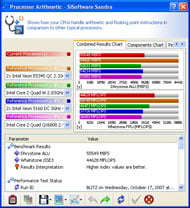Intel Core 2 Extreme QX9650 - Yorkfield Has Landed
Test Systems and SiSoft SANDRA

How we configured our test systems: When configuring our test systems for this article, we first entered their respective system BIOSes and set each board to its "Optimized" or "High performance Defaults". We then saved the settings, re-entered the BIOS and set memory timings for either DDR2-800 with 4,4,4,12 timings or DDR3-1333 with 5,5,5,15 timings. The hard drives were then formatted, and Windows XP Professional (SP2) was installed. When the Windows installation was complete, we installed the drivers necessary for our components, and removed Windows Messenger from the system. Auto-Updating and System Restore were then disabled and we set up a 1024MB permanent page file on the same partition as the Windows installation. Lastly, we set Windows XP's Visual Effects to "best performance," installed all of our benchmarking software, defragged the hard drives, and ran all of the tests.
|
|
System 1: Asus Blitz Extreme 2x1GB Corsair PC3-14400 GeForce 8800 GTX WD740 "Raptor" HD Windows XP Pro SP2 |
System 2: Asus CrossHair 2x1GB Corsair PC-6400 GeForce 8800 GTX WD740 "Raptor" HD Windows XP Pro SP2 |
|
We began our testing with SiSoftware's SANDRA XII, the System ANalyzer, Diagnostic and Reporting Assistant. We ran six of the built-in subsystem tests that partially comprise the SANDRA XII suite with the Core 2 Extreme QX9650 (CPU Arithmetic, Multimedia, Multi-Core Efficiency, Memory, Cache, and Memory Latency). All of the scores reported below were taken with the processor running at its default clock speed of 3.0GHz.
The SANDRA processor arithmetic and multimedia benchmarks show the new Core 2 Extreme QX9650 finishing just ahead of similarly clocked Core micro-architecture based Core 2 Extreme and Xeon processors, which is just what we had expected. The memory bandwidth benchmark shows the QX9650 / P35 / DDR3 combination with a peak of 7.4GB/s of available memory bandwidth and the memory latency benchmark has the platform outpacing all of the similar reference points in the SANDRA database. The really interesting results here are the 'cache and memory' and multi-core efficiency tests, however. In the cache and memory test, the new Core 2 Extreme QX9650 has a large combined cache/memory bandwidth advantage as well as a lower (better) speed factor rating. And in the multi-core efficiency benchmark, once we get past the 32k block size mark, the QX9650 has vastly improved inter-core bandwidth in comparison to the other Core 2 Quad processors listed. This should pay dividends in multi-threaded applications where data must be shared between the processor cores.












